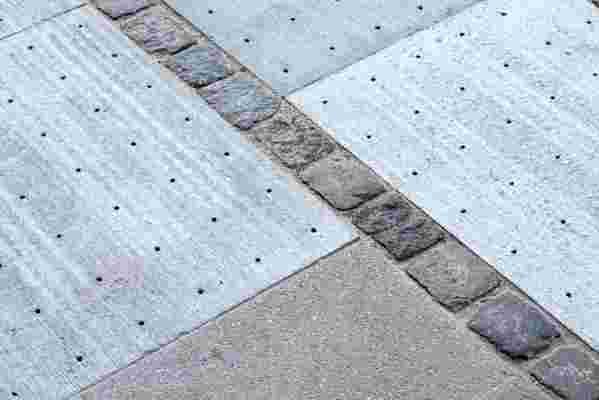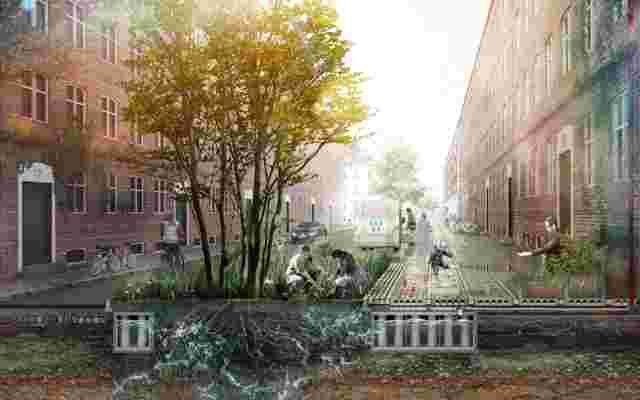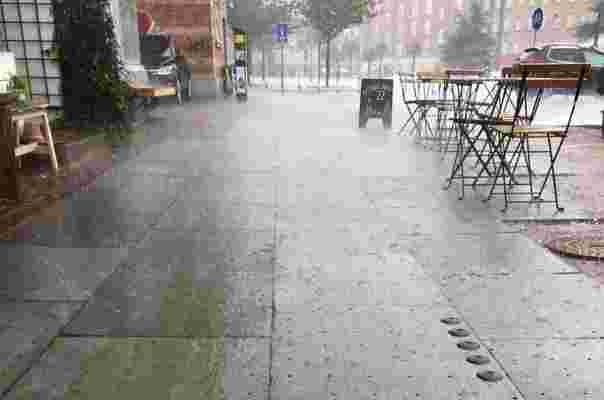Last night, after an intense, hour-long rainstorm, New York City's sewer grates were overrun with water, which quickly became large puddles. For those standing on any given street corner, the scenario soon turned movie-like: Passing cars hitting the puddles and splashing water onto unsuspecting bystanders (it may have even happened to this writer). This problem, of course, isn't New York–centric. And the issues of post-storm flooding can be much more serious than splashing water from passing cars. Cities and towns across the globe struggle with street flooding after heavy rainstorms (a problem that has only been exacerbated due to climate change). Yet, one strip of sidewalk in Copenhagen appears to have solved this concern, one neighborhood at a time.
"In Copenhagen we often experience severe rainstorms and each time it costs the city a lot of money," says Flemming Rafn Thomsen, cofounder of the Danish architecture firm Third Nature. "This problem inspired us to design a tile that is permeable like the earth's crust, allowing water to seep through and drain in nearby gardens and fields." Thomsen used his background in architecture and desire to alleviate the city's flooding to cofound Climate Tile, a start-up aimed at climate adaptation systems for urban environments.

A close-up view of the newly designed sidewalk shows the holes that allow water to naturally flow through to a subterranean storage unit.
This led Thomsen and his Third Nature partner Ole Schrøder on a five-year journey of experimentation, which ended in the creation of a sidewalk dotted with small holes, allowing the walkway to collect and distribute the water to nearby vegetation. This month, Thomsen's team installed a 165-foot stretch of permeable sidewalk in Copenhagen's Nørrebro neighborhood. And the results have been promising.

A rendering shows a cross-section of the sidewalk and how water is stored underground, to be distributed either in the moment or at a later time.
The way the system works is quite simple. Rainwater passes through the tiles, collecting underneath in a manmade aquifer. From there, the excess water can be stored or diverted to any nearby garden or field to naturally water plants, grass, or trees. This not only deals with flash floods, but will also help maintain a healthy ecosystem in densely urban environments.

A look at the new sidewalk in the midst of a heavy rainstorm.
The tiles produced by Climate Tile are currently slightly more expensive than a traditional cement tile made for sidewalks, but that doesn't deter Thomsen. "It remains the cheapest climate adaptation system to date. And over time, there could be real monetary returns that come from harvesting the rainwater or cost benefits associated with the mitigation of urban heat." Ever the optimist, it's not the current rollout that has Thomsen excited, it's what the future holds for this technology. "The whole idea is to make a standard tile that can be seamlessly added onto existing pavements. We want to take the eco-friendly measure a step further. Right now we're currently working on an experimental concrete mix that uses red brick tile waste and uses upwards of 30 percent less carbon emission during production."
The question remains, will this new technology be coming to your city or town anytime soon? "We've certainly received a lot of interest from around the globe, particularly from cities in Denmark, Germany, and Canada," says Thomsen. "But what we are really working toward is finding a distributor that can take the product to the market, scale it, and allow many more communities to benefit from it."
